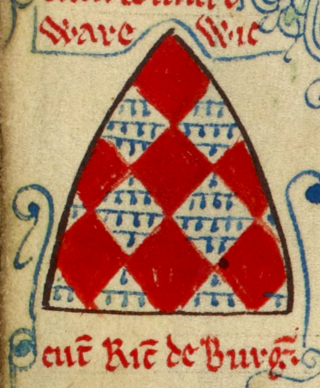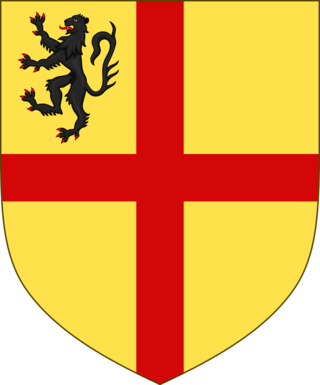
The House of Burgh or Burke was an ancient Anglo-Norman and later Hiberno-Norman aristocratic dynasty who held the earldoms of Kent, Ulster, Clanricarde, and Mayo at various times, provided one Queen Consort of Scotland, and played a prominent role in the Norman invasion of Ireland.

William de Burgh was the founder of the House of Burgh in Ireland and elder brother of Hubert de Burgh, 1st Earl of Kent and Geoffrey de Burgh, Bishop of Ely.

Richard Mór de Burgh, 1st Lord of Connacht, was a Hiberno-Norman aristocrat who was Seneschal of Munster and Justiciar of Ireland (1228–32).
Sir William Óg de Burgh was an Anglo-Irish noble and soldier who was the ancestor of the Earls of Clanricarde and the Mac William Iochtar.
The Burke/de Burgh Civil War was a conflict in Ireland from 1333 to 1338 between three leading members of the de Burgh (Burke/Bourke) Anglo-Norman family resulting in the division into three clans.

Sir Uilleag (Ulick) de Burgh (Burke), 1st Clanricarde or Mac William Uachtar was an Irish chieftain and noble who was leader of one of the three factions who fought the Burke Civil War in the 1330s. By the end of the conflict he had established himself and his descendants as Clanricarde, also known as Mac William Uachtar, independent lords of Galway. He was succeeded by his son, Richard Óg Burke, 2nd Clanricarde (d.1387).

Clanricarde, also known as Mac William Uachtar or the Galway Burkes, were a fully Gaelicised branch of the Hiberno-Norman House of Burgh who were important landowners in Ireland from the 13th to the 20th centuries.

Felim O'Connor was king of Connacht in Ireland, having been proclaimed king by Richard Mór de Burgh in 1230, he reigned proper from 1233 until 1265. Felim died in that year and was buried in the Dominican Priory in Roscommon which he founded in 1253. On his accession Felim inherited many problems from his predecessors, having his territory limited to essentially County Roscommon and having to deal with an increase of English and Welsh settlers in the kingdom. Felim attempted to maintain both a loyal and personal relationship with Henry III King of England, hoping he would limit the influence of de Burgh and other powerful Anglo-Norman magnates in Connacht, but this policy of appeasement produced few concrete results. During Felim's reign the lands of the Ua Conchobair became limited to the five 'royal cantreds', essentially Co. Roscommon. Felim notably adopted aspects of Anglo-Norman culture as seen in his English style effigy and seal.
The Battle of Knockdoe took place on 19 August 1504 at Knockdoe, in the Parish of Lackagh, County Galway, between two Anglo-Irish lords—Gerald FitzGerald, Earl of Kildare, the Lord Deputy of Ireland, and Ulick Fionn Burke, 6th Clanricarde (d.1509)—along with their respective Irish allies. The cause was a dispute between Maelsechlainn mac Tadhg Ó Cellaigh (O'Kelly), King of Ui Maine – Mod. Irish Uí Mháine) and Clanricarde. The major contemporary sources for this battle are the Gaelic Irish annals and a sixteenth-century manuscript written in the Pale known as "the Book of Howth".

Maud 'Matilda' le Vavasour, Baroness Butler was an Anglo-Norman heiress and the wife of Fulk FitzWarin, a medieval landed gentleman who was forced to become an outlaw in the early 13th century, who is allegedly linked to the tale of Robin Hood and its origins.
Egidia de Lacy, Lady of Connacht, was a Cambro-Norman noblewoman, the wife of Richard Mór de Burgh, 1st Baron of Connaught and Strathearn (c.1194–1242), and the mother of his seven children, including Walter de Burgh, 1st Earl of Ulster. She was also known as Gille de Lacy. Egidia was the daughter of Walter II de Lacy by his second wife Margaret de Braose.
Juliana FitzMaurice, Lady of Thomond was a Anglo-Norman noblewoman, the daughter of Maurice FitzGerald, 3rd Lord of Offaly, and the wife of Thomas de Clare, Lord of Thomond, a powerful Anglo-Norman baron in Ireland, who was a younger brother of Gilbert de Clare, 6th Earl of Hertford. Juliana was married three times; Thomas being her first. She is sometimes referred to as Juliane FitzMaurice.
Maud de Prendergast, Lady of Offaly, was a Norman-Irish noblewoman, the first wife of Maurice FitzGerald, 3rd Lord of Offaly, Justiciar of Ireland, and the mother of his two daughters, Juliana FitzGerald and Amabel. She married three times; Maurice FitzGerald, 3rd Lord of Offaly was her third husband.
Maurice FitzMaurice FitzGerald was an Irish magnate, soldier, and Justiciar of Ireland from 1272 to 1273. His family would come to epitomise the ideal of cultural synthesis in Ireland, becoming "more Irish than the Irish themselves", fusing Gaelic and Norman customs in Irish identity. "But others say he never enjoyed that lordship himself, but that it passed to the son and grandson of his eldest brother Gerald."
Tomás Bobhdacing, founder of the Bodkin family of The Tribes of Galway, fl. c. 1300.
William Liath de Burgh was an Irish noble and deputy Justiciar of Ireland (1308–09).

Ulick Fionn Burke, 6th Clanricarde or Mac William Uachtar was an Irish chieftain and noble.
Richard Óg de Burgh was an Anglo-Irish noble and soldier who was the ancestor of de Burgh/Burkes of Clanricarde.
Meiler FitzHenry was a Cambro-Norman nobleman and Lord Chief Justice of Ireland during the Lordship of Ireland.

Richard Óg de Burgh, 2nd Earl of Ulster and 3rd Baron of Connaught, called The Red Earl, was one of the most powerful Irish nobles of the late 13th and early 14th centuries and father of Elizabeth, wife of King Robert the Bruce of Scotland.





